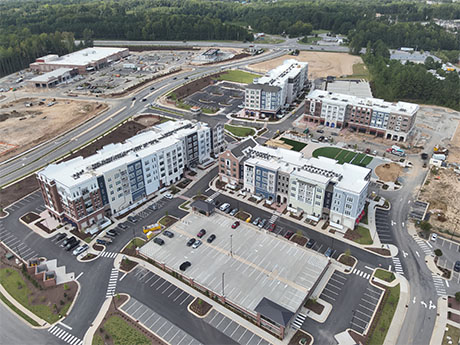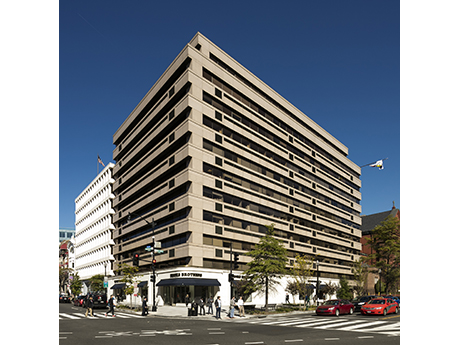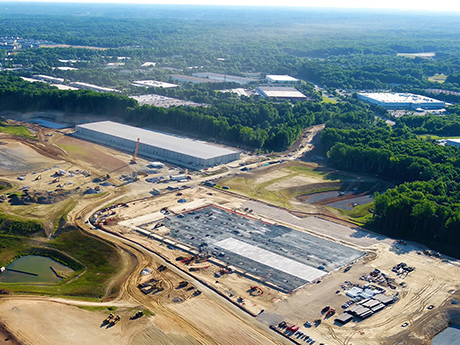The secret is getting out about Apex, a western suburb of Raleigh that also lies 20 miles south of Chapel Hill. In 2018, Realtor.com ranked the city as the No. 1 fastest growing suburb in the United States. This was aided by the master planning of local homebuilder/developer ExperienceOne Homes, which debuted its large-scale Sweetwater residential development in 2016. The allure of Apex didn’t stop there as the local schools within the Wake County Public School System have long been considered top-notch. As more and more families moved to the once-sleepy town, the need for community-serving retail became apparent. And not just any sprawling shopping center would suffice. Retail Strategies of N.C. Inc., on behalf of development partner The Kalikow Group, a multifamily and mixed-use development firm based in Westbury, New York, and the aforementioned ExperienceOne, set out to create a sense of place that would resemble village towns in Northeast states such as Maine and Massachusetts. What all of these hamlets have in common is they are built up over decades around a town center, thus the idea of Sweetwater Town Center was established. East Side The “hard part” was essentially in the rearview mirror as ExperienceOne had already …
Southeast Market Reports
For all Top 50 NMHC third-party management firms, the subject of managing rising operating costs is a topic that has come to be front and center in many recent client conversations. “As 2025 budget discussions were taking center stage toward the end of 2024, our clients increasingly highlighted the issues of rising operating costs,” says Lisa Narducci-Nix, director of business development at Drucker + Falk. “This trend”, she adds, “underscores our need for strategic planning and cost management to navigate the continued challenges ahead.” The multifamily sector is facing unprecedented headwinds as operating costs continue to rise, driven by factors ranging from inflation and labor shortages to increased insurance premiums and energy expenses. As a result, multifamily operators are working to find ways to maintain profitability while providing quality living spaces for their residents. “In this challenging environment, it is clear to us that adapting to these rising costs will require a multifaceted approach — one that blends innovation, strategic marketing, operational efficiency and technological adoption,” says Narducci-Nix. Challenges of rising costs Across its 11-state footprint spanning over 42,000 units, Drucker + Falk has seen operating costs for many of its managed assets surge in recent years. The supply chain …
Multifamily Supply Hits Record High in Raleigh-Durham as Development Pipeline Empties
by John Nelson
This year, multifamily housing starts nationally are on pace to hit their lowest levels since 2014, a period marked by the national economy’s gradual recovery from the Great Financial Crisis. Year to date, multifamily deliveries have exceeded starts by 218,500 units, creating a substantial shortfall that signals a significantly reduced apartment supply by 2026. The same trend is taking effect in Raleigh-Durham, where completions exceeded starts by 4,935 units. This is a key consideration for most apartment investment strategies today, explaining why many buyers are willing to accept Year 1 challenges such as softness or negative leverage. As the current supply wave peaks in the Triangle, the future pipeline of multifamily construction is shaping up quite different. Of the identified units that are scheduled for delivery in 2024, nearly 42 percent of units have been delivered as of this writing. Of the approximately 18,600 apartments currently under construction across the Triangle, 13,343 of those are expected to be delivered by the end of third-quarter 2025, with a majority in Central and Southeast Raleigh. However, new activity has slowed significantly — inventory growth by 2027 is projected to drop by more than 85 percent, plummeting to a 3.6 percent rate compared …
In the summer of 2012, fresh out of college and starting my career in retail brokerage at KLNB, a seasoned retail broker-turned-developer warned me to consider other careers. “Retail is dying,” he said. “Why would people go to stores when it’s so easy to order online?” Well, it’s been 12 years since that moment, and I’m still waiting for the retail boogeyman to appear. As I write this, I’m happy to report he hasn’t arrived — and the data suggests he’s nowhere in sight. The Washington, D.C., metropolitan statistical area (MSA) is now in its tightest fundamental position on record due to limited new supply and continued demand from national, regional and franchised concepts. In the Washington, D.C. market, we have the second-lowest retail square footage per capita among major MSAs, with new retail supply representing just 0.4 percent of total inventory. This places the Capital Region in the bottom quartile of retail real estate inventory growth among national MSAs that have more than 100 million square feet of existing inventory. The result? Retail availability in the D.C. metro has decreased to 4.8 percent (compared to the national average of 4.7 percent), down from 5.1 percent year-over-year and 5.3 percent …
The Washington, D.C., office market is facing challenging times, marked by unprecedented vacancy rates, dwindling demand and a significant supply-demand imbalance. Within these constraints, the flight to quality trend is reshaping how investors and lenders view office assets and should lead to an inventory reclassification. The divide between high-quality assets and lesser properties widens almost daily, creating a bifurcated market with fierce competition for quality space. Meanwhile, older, less desirable properties languish, accumulating vacancies as they fail to meet current occupier expectations. Without intervention, the less desirable properties will continue to drag down the market’s perception, obscuring the success of top-tier spaces with a headline vacancy rate. To contribute to the stabilization of the market, office participants must acknowledge this divide and assess distressed assets not as liabilities, but as opportunities to reset and reclassify properties based on realistic usage and demand. Lenders are central to this process as they control a substantial portion of distressed office stock. After years of extending loans to stave off foreclosure during uncertain times, many are now realizing that relief is unlikely to materialize organically. As a result, foreclosures are already up 121 percent in 2024 year-to-date over 2023 in Washington, D.C. On average, …
— By Patti Dillon, Executive Vice President, Colliers — Las Vegas’ office market is at a critical juncture as shifting dynamics could shape its future for years to come. New developments like the anticipated 30-acre studios development project in discussion with Howard Hughes Corporation present opportunities, though second-generation office space is expected to dominate over the next three to five years. This shift is driven by cost efficiency, evolving tenant demands and the higher expenses tied to new construction. Though new builds offer state-of-the-art facilities, the adaptability and affordability of second-generation spaces make them a practical solution for many businesses. Las Vegas continues to attract high-profile corporate tenants from out of state. These companies are drawn to flexible office spaces that feature modern technology and proximity to mixed-use developments that support the evolving hybrid work model. The increasing demand for live-work-play environments has placed a premium on mixed-use developments that combine residential, office and retail spaces. Despite ongoing demand, the market faces significant challenges. Investor confidence has been impacted by broader economic factors, including the U.S. elections, geopolitical tensions and inflationary pressures. Supply chain disruptions, rising construction costs and higher interest rates also create barriers for developers and limit financing options …
Resilient DC Industrial Market Is Growing But Softening as Vacancy Rates Creep Higher
by John Nelson
The U.S. industrial real estate market continues to sustain, with national vacancy rates steadily creeping toward 7 percent (6.8 percent at the time of this writing). Over the past three years, the industrial real estate market continued to set records and became known as the darling asset class within the commercial real estate community. However, the market is showing signs of reversion to historical velocity and vacancy rates. The industrial vacancy rate is steadily climbing in the Washington, D.C., metro area as demand softens for third-party logistics in second-quarter 2024. Vacancies are up to 6.5 percent after reaching an all-time low of 3.8 percent at the end of 2022. The market remains tight by historical measures. However, normalized leasing velocity, a few large tenant moveouts and reduced demand is expected to provide upward pressure on the vacancy rate in 2025. Subleasing activity trended upward in the past six to 12 months to over 1.3 million square feet. A few examples of large sublets include 393,000 square feet put on the market at Capital Gateway in Brandywine; Builders First Source moved out of 135,000 square feet at Plaza 500 in Alexandria; and in the second quarter, Western Express vacated 102,000 square …
The multifamily market in the Washington, D.C., metro area has experienced meaningful shifts in 2024, marked by moderate demand, consistent construction and evolving investment patterns. As a major urban hub, D.C. continues to attract both local and out-of-state investors eager to tap into its growing potential. Out-of-state capital A key trend in the D.C. multifamily market is the strong influx of out-of-state capital. This year, 44 percent of buyers in our DMV (D.C., Maryland and Virginia) listings came from outside the region, drawn by the area’s stability and long-term growth potential. These out-of-market investors often pay a premium over local buyers, keeping deal volume and pricing competitive even amid rising interest rates. This steady inflow of external capital has reinforced the market’s resilience, underscoring the perceived value of D.C. multifamily assets. The demand from out-of-state investors has also provided stability to the market, helping to sustain price levels and liquidity despite macroeconomic headwinds. By bolstering interest in multifamily properties, this capital flow supports continued growth and positions D.C. as a desirable destination for long-term investment. As this trend persists, the D.C. metro area is likely to remain a focal point for diverse capital sources, ensuring strength and adaptability in its …
Atlanta remains one of the most desirable markets in the country for investors due to its diverse economy, below-national average unemployment rate, steady increase in jobs and population growth. These market fundamentals have translated to a well-performing multifamily market that, despite short-term macro challenges, is in a unique favorable position due to its relatively low supply compared to other peer Sunbelt markets. Demand for multifamily has seen a rebound in 2024 and Atlanta has been resilient in the middle of a multi-year supply wave. Over the past two years, the market delivered approximately 35,000 units and that number is expected to drop to just 9,000 units in 2025 and less than 4,000 units in 2026. This will lead to tightening occupancies and strong rent growth. The city has already recorded its seventh consecutive quarter of net positive net absorption as of the second quarter of 2024, which is a quarterly high since mid-2021 at 5,799 units. New development, on the other hand, has been a bit more challenging due to the higher return on cost requirements, flat rent growth and a lack of meaningful relief on construction costs. Market valuations for newly constructed assets are near current replacement cost, which …
Atlanta’s office market feels like a story of winners and losers. Tenants continue to pay increasing rents for the best located, highest-quality spaces while the sector overall experiences negative office absorption. Those big, shiny objects, so to speak, offer quite a contrast to the results of continued office sector adversity brought on by reduced office attendance, a downsizing leasing trend and swelling sublet space. Who’s in the best position to win? Well-capitalized owners with stabilized debt (or none) that can meet the increasing tenant demands for skyrocketing tenant improvement costs and other rental concessions. With continued construction cost increases and downward pressure on base rental rates, fiscally sound landlords with longer-term business plans are in the best position to transact. And, of course, the newest buildings with the best location, amenity package and a reasonable commute for the majority of the workforce continue to thrive. CoStar Group reports that during the past 12 months, net absorption in office buildings completed before 2020 was negative 4 million square feet compared to 1.1 million for newer properties. The Atlanta office market has produced some sizable transactions this year, fueling some optimism among landlords with larger blocks of space for lease. The most …




